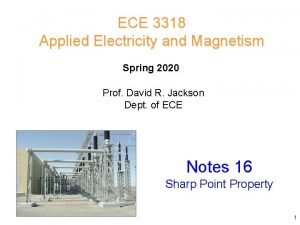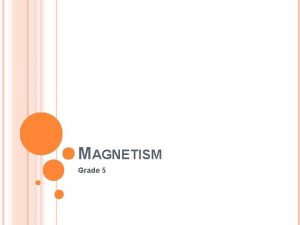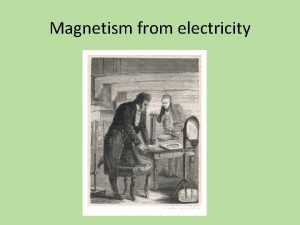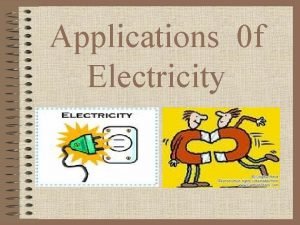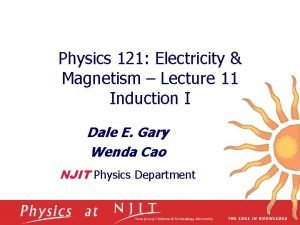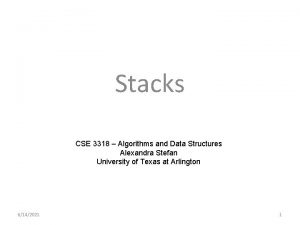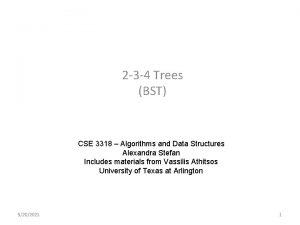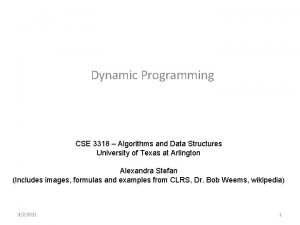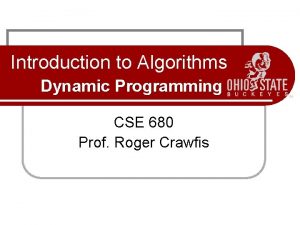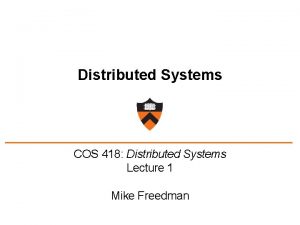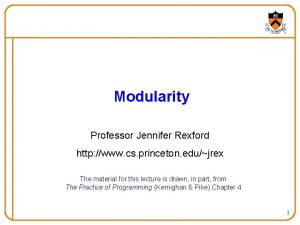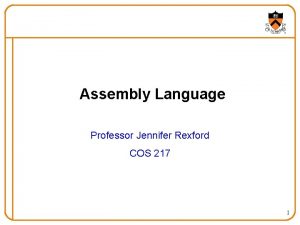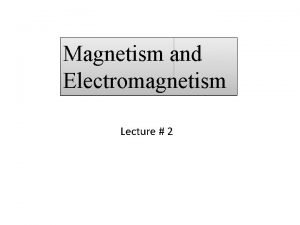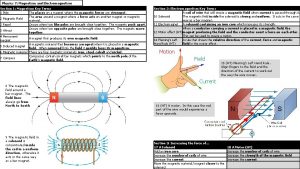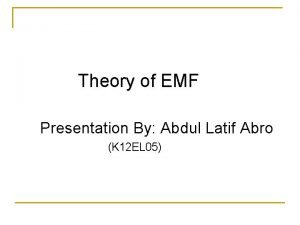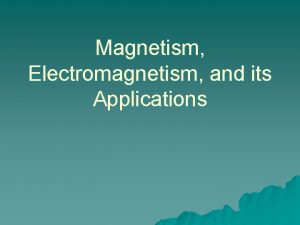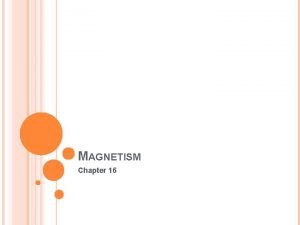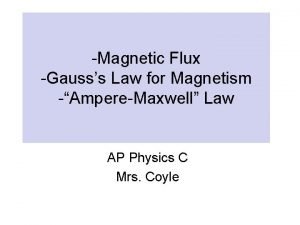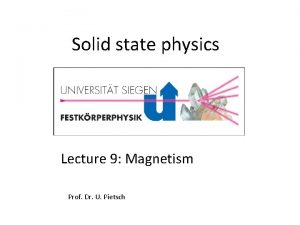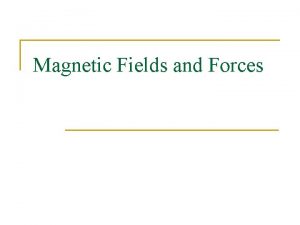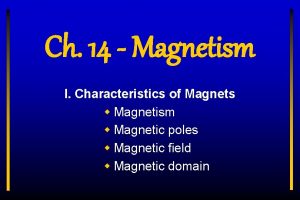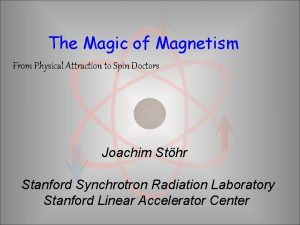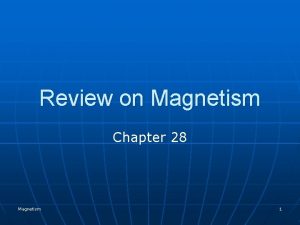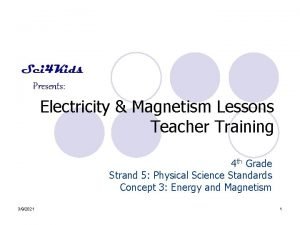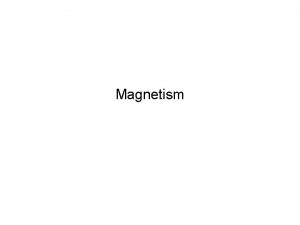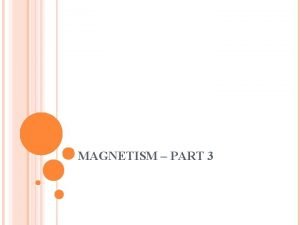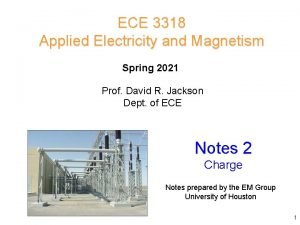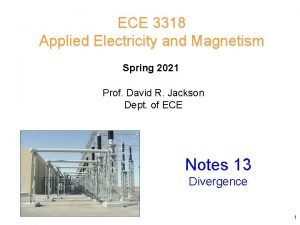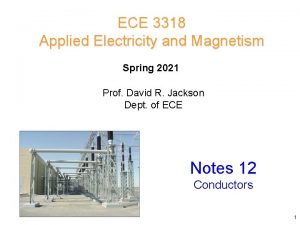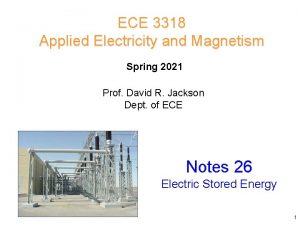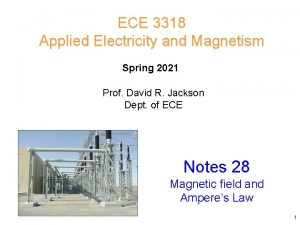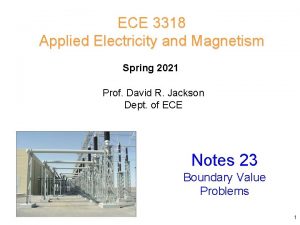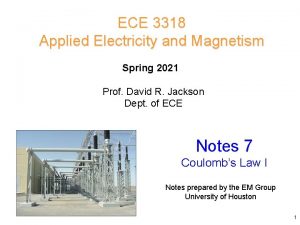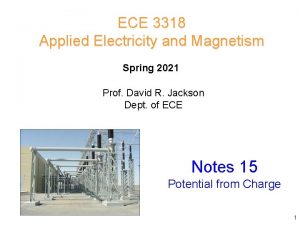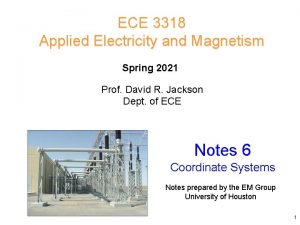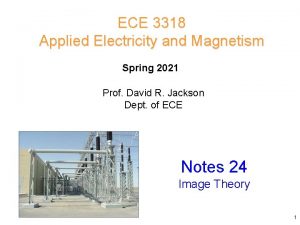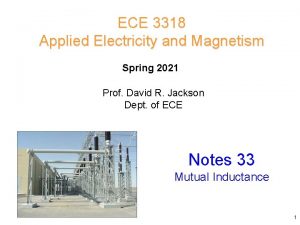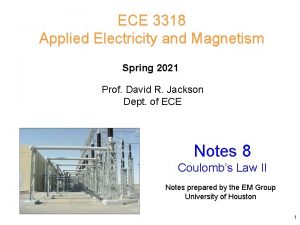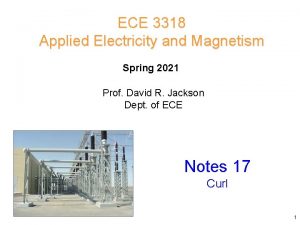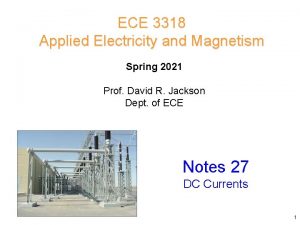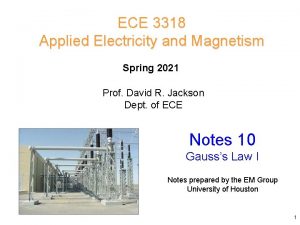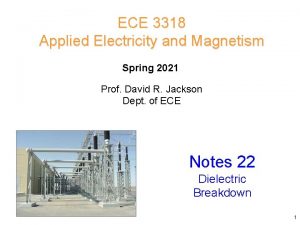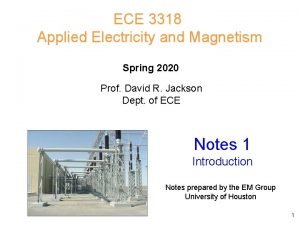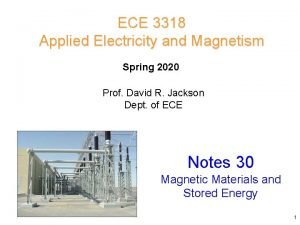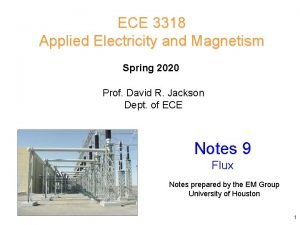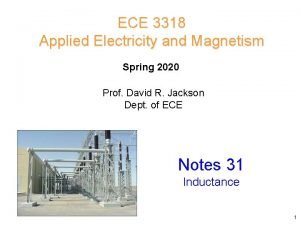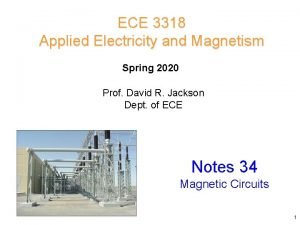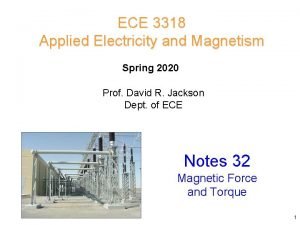ECE 3318 Applied Electricity and Magnetism Spring 2021






















































- Slides: 54

ECE 3318 Applied Electricity and Magnetism Spring 2021 Prof. David R. Jackson Dept. of ECE Notes 18 Faraday’s Law 1

Example (cont. ) Find curl of E from a static point charge 2

Example (cont. ) Note: If the curl of the electric field is zero for the field from a static point charge, then by superposition it must be zero for the field from any static charge density. This gives us Faraday’s law: (in statics) 3

Faraday’s Law in Statics (Integral Form) Stokes's theorem: Here S is any surface that is attached to C. Hence 4

Faraday’s Law in Statics (Differential Form) We show here how the integral form also implies the differential form. Assume We then have (definition of curl): Hence 5

Faraday’s Law in Statics (Summary) Differential (point) form of Faraday’s law Stokes’s theorem Definition of curl Integral form of Faraday’s law 6

Path Independence and Faraday’s Law The integral form of Faraday’s law is equivalent to path independence of the voltage drop calculation in statics. Proof: Also, Hence, 7

Summary of Path Independence Equivalent properties of an electrostatic field Equivalent 8

Summary of Electrostatics Here is a summary of the important equations related to the electric field in statics. Electric Gauss law Faraday’s law Constitutive equation (free space) 9

Faraday’s Law: Dynamics Experimental Law (dynamics): This is the general Faraday’s law in dynamics. Michael Faraday* (from Wikipedia) *Ernest Rutherford stated: "When we consider the magnitude and extent of his discoveries and their influence on the progress of science and of industry, there is no honour too great to pay to the memory of Faraday, one of the greatest scientific discoverers of all time". 10

Faraday’s Law: Dynamics (cont. ) Assume a Bz field that increases with time: The changing magnetic field produces an electric field. Experiment Magnetic field Bz (increasing with time) Electric field E 11

Faraday’s Law: Dynamics (cont. ) A changing magnetic field produces a circulating electric field. Magnetic field Bz (increasing with time) Electric field E 12

Eddy Currents Cylindrical coordinates Assume no variation Transformer core Magnetic field Bz (increasing with time) Electric field E 13

Eddy Currents (cont. ) (phasor domain) Assume: Transformer core Solution: 14

Eddy Currents (cont. ) Also, we have Ohm’s law: Hence we have: Transformer core Eddy currents Note that the eddy currents increase with frequency. 15

Eddy Currents (cont. ) Laminated cores are used to reduce eddy currents. Solid core The laminated core consists of layers of iron material coated with electrical insulation. Laminated core 16

Faraday’s Law: Integral Form Integrate both sides over an arbitrary open surface (bowl) S: Apply Stokes’s theorem for the LHS: Note: The right-hand rule determines the direction of the unit normal, from the direction along C. Faraday's law in integral form 17

Faraday’s Law: Integral Form (cont. ) Assume that the surface and the path are not changing with time: Define magnetic flux through the surface S: We then have Note: The right-hand rule determines the direction of the unit normal in the flux calculation, from the direction along C. 18

Faraday’s Law: Summary Stationary surface where The voltage drop around a closed path is equal to the rate of change of magnetic flux through the path. Note: The closed path can be anything: in free space, inside of a metal wire, etc. 19

Eddy Currents (Revisited) Solid core Integral form of Faraday's law: This is the same result we obtained before, using the differential form of Faraday's law. 20

Faraday’s Law for a Loop We measure a voltage across a loop due to a changing magnetic field inside the loop. (This is the basis for how AC generators and transformers work. ) + Open-circuited loop Magnetic field B (Bz is changing with time) 21

Faraday’s Law for a Loop (cont. ) + Note: A lower case v denotes that it is time-varying. - Also So we have Note: The voltage drop along the PEC wire (from B to A inside the wire) is zero. 22

Faraday’s Law for a Loop (cont. ) Final Result + - 23

Faraday’s Law for a Loop (cont. ) Assume a uniform magnetic field for simplicity. (At least it is uniform over the loop area. ) Assume Then we have: + so A = area of loop 24

Faraday’s Law for a Loop (cont. ) Summary Assume General form + - Uniform field A = area of loop z = magnetic flux through loop in z direction 25

Lenz’s Law This is a simple rule to tell us the polarity of the output voltage (without having to do any calculation). We visualize a high-impedance resistor R added to the circuit: Assume + The output voltage polarity corresponds to a current flow that opposes the change in the flux in the loop. - In this example, a clockwise current is set up, since this opposes the change in flux through the loop. The clockwise current then corresponds to the output voltage polarity shown. Note: A right-hand rule tells us the direction of the magnetic field due to a wire carrying a current. A = area of loop Bz is increasing with time. (A wire carrying a current in the z direction produces a magnetic field in the positive direction. ) 26

Example: Magnetic Field Probe A small loop can be used to measure the magnetic field (for AC). + Note: Assume The magnetic field is assume constant over the loop area. - Assume Then we have A = area of loop At a given frequency, the output voltage is proportional to the strength of the magnetic field. 27

Applications of Faraday’s Law Faraday’s law explains: § How AC generators work § How transformers work Output voltage of generator Output voltage on secondary of transformer Note: For N turns in a loop we have 28

The world's first electric generator! (invented by Michael Faraday) A magnet is slid in and out of the coil, resulting in a voltage output. (Faraday Museum, London) 29

The world's first transformer! (invented by Michael Faraday) The primary and secondary coils are wound together on an iron core. (Faraday Museum, London) 30

AC Generators Diagram of a simple alternator (AC generator) with a rotating magnetic core (rotor) and stationary wire (stator), also showing the output voltage induced in the stator by the rotating magnetic field of the rotor. + Open-circuit coil - (Magnetic flux comes out of the north pole. ) z A = area of loop http: //en. wikipedia. org/wiki/Alternator 31

AC Generators (cont. ) Open-circuit coil + so or z (phasor domain) A = area of loop 32

AC Generators (cont. ) Open-circuit coil + Summary - If the magnet rotates at a fixed speed, a sinusoidal voltage output is produced. z Note: The angular velocity of the magnet is the same as the radian frequency of the output voltage. A = area of loop 33

AC Generators (cont. ) Thévenin Equivalent Circuit + Open-circuit coil + - N turns z A = area of loop 34

AC Generators (cont. ) Generators at Hoover Dam 35

AC Generators (cont. ) Generators at Hoover Dam 36

Transformers A transformer changes an AC signal from one voltage to another. http: //en. wikipedia. org/wiki/Transformer 37

Transformers (cont. ) v High voltages are used for transmitting power over long distances (less current means less conductor loss). v Low voltages are used inside homes for convenience and safety. http: //en. wikipedia. org/wiki/Electric_power_transmission 38

Transformers (cont. ) Note: The sign is correct from Lens’ law. Hence Note: The sign is correct from Lens’ law. Ideal transformer (no flux leakage): (time domain) (phasor domain) http: //en. wikipedia. org/wiki/Transformer 39

Transformers (cont. ) Ideal transformer (no losses): (power in = power out) Hence so (time domain) (phasor domain) 40

Transformers (cont. ) Impedance transformation (phasor domain): 41

Transformers (cont. ) Hence so 42

Transformers (cont. ) Impedance transformation 43

Transformers (cont. ) Example: Audio matching circuit The PA should see a matched load (50 [ ]) for maximum power transfer to the load (speaker). Audio output circuit Power amplifier (PA) Transformer 44

Transformers (cont. ) Isolation transformer An isolation transformer is used isolate the input and output circuits (no direct electrical connection between them). It can be used to connect a grounded circuit to an ungrounded one. The transformer is being used as a form of “balun”, which connects a “balanced circuit” (the two leads are at a +/- voltage with respect to ground) to an “unbalanced circuit” (where one lead is grounded). Ungrounded input Grounded output 45

Measurement Error from Magnetic Field Find the voltage readout on the voltmeter. Perfectly conducting leads + + - - Voltmeter Applied magnetic field: Note: The voltmeter is assumed to have a very high internal resistance, so that negligible current flows in the circuit. (We can neglect any magnetic field coming from the current flowing in the loop. ) 46

Measurement Error from Magnetic Field (cont. ) Faraday’s law: + + - - Voltmeter Perfectly conducting leads 47

Measurement Error from Magnetic Field (cont. ) From the last slide, Therefore + + - - Voltmeter Perfectly conducting leads or Note: There is no voltage drop along the perfectly conducting leads. 48

Measurement Error from Magnetic Field (cont. ) Summary Perfectly conducting leads + + - - Voltmeter Practical note: In such a measurement, it is good to keep the leads close together (or even better, twist them. ) 49

Twisted Pair Transmission Line Twisted pair is used to reduced interference pickup in a transmission line, compared to “twin lead” transmission line. CAT 5 cable (twisted pair) Balun Twin lead Coax Note: Coaxial cable is perfectly shielded and has no interference. 50

Maxwell’s Equations (Differential Form) Electric Gauss law Faraday’s law Magnetic Gauss law Ampere’s law Constitutive equations 51

Maxwell’s Equations (Integral Form) Electric Gauss law Faraday’s law Magnetic Gauss law Ampere’s law 52

Maxwell’s Equations (Statics) In statics, Maxwell's equations decouple into two independent sets. Electrostatics Magnetostatics 53

Maxwell’s Equations (Dynamics) In dynamics, the electric and magnetic fields are coupled together. Each one, changing with time, produces the other one. Example: A plane wave propagating through free space E z H power flow From ECE 3317: 54
 Ece 3318
Ece 3318 Physics 102
Physics 102 Ib physics topic 5 questions
Ib physics topic 5 questions Magnetism
Magnetism Electricity jeopardy
Electricity jeopardy Sph3u electricity and magnetism
Sph3u electricity and magnetism Relationship between electricity and magnetism
Relationship between electricity and magnetism Magnetic susceptibility formula
Magnetic susceptibility formula Magnetism grade 5
Magnetism grade 5 Electricity and magnetism
Electricity and magnetism Electricity and magnetism
Electricity and magnetism Electricity and magnetism
Electricity and magnetism Electricity and magnetism
Electricity and magnetism Electricity and magnetism
Electricity and magnetism Electricity and magnetism vocabulary
Electricity and magnetism vocabulary Static electricity and current electricity
Static electricity and current electricity Current electricity
Current electricity Cse 3318
Cse 3318 Cse 3318
Cse 3318 Cse 3318
Cse 3318 Cse 3318
Cse 3318 Spring, summer, fall, winter... and spring (2003)
Spring, summer, fall, winter... and spring (2003) Winter spring summer fall months
Winter spring summer fall months Auca online registration
Auca online registration Cos 418
Cos 418 Cos418
Cos418 Cos217 spring 2021
Cos217 spring 2021 Cos217 spring 2021
Cos217 spring 2021 Cos217 spring 2021
Cos217 spring 2021 Cos217 spring 2021
Cos217 spring 2021 Magnetic lines of force
Magnetic lines of force Magnetism and electromagnetism
Magnetism and electromagnetism Bbc bitesize electric bell
Bbc bitesize electric bell Para and ferro magnetism
Para and ferro magnetism Electromagnetism vs magnetism
Electromagnetism vs magnetism Define magnet and magnetism
Define magnet and magnetism Magnetism and gauss law
Magnetism and gauss law Magnetism love
Magnetism love Magnetism
Magnetism Use of magnet to separate the mixture
Use of magnet to separate the mixture Hans christian oersted magnetism
Hans christian oersted magnetism An invisible pulling force
An invisible pulling force Magnetism is an invisible
Magnetism is an invisible Electromagnetic particle inspection
Electromagnetic particle inspection Magnetic flux units
Magnetic flux units Facts about magnetism
Facts about magnetism Concept of displacement current
Concept of displacement current Renaldo and nasreen build an electromagnet
Renaldo and nasreen build an electromagnet Conceptual physics magnetism
Conceptual physics magnetism 14 characteristics of magnetism
14 characteristics of magnetism Magnetism
Magnetism Magnetism
Magnetism Basics of magnetism
Basics of magnetism The phenomenon of magnetism is best understood in terms of
The phenomenon of magnetism is best understood in terms of Magnetism
Magnetism
